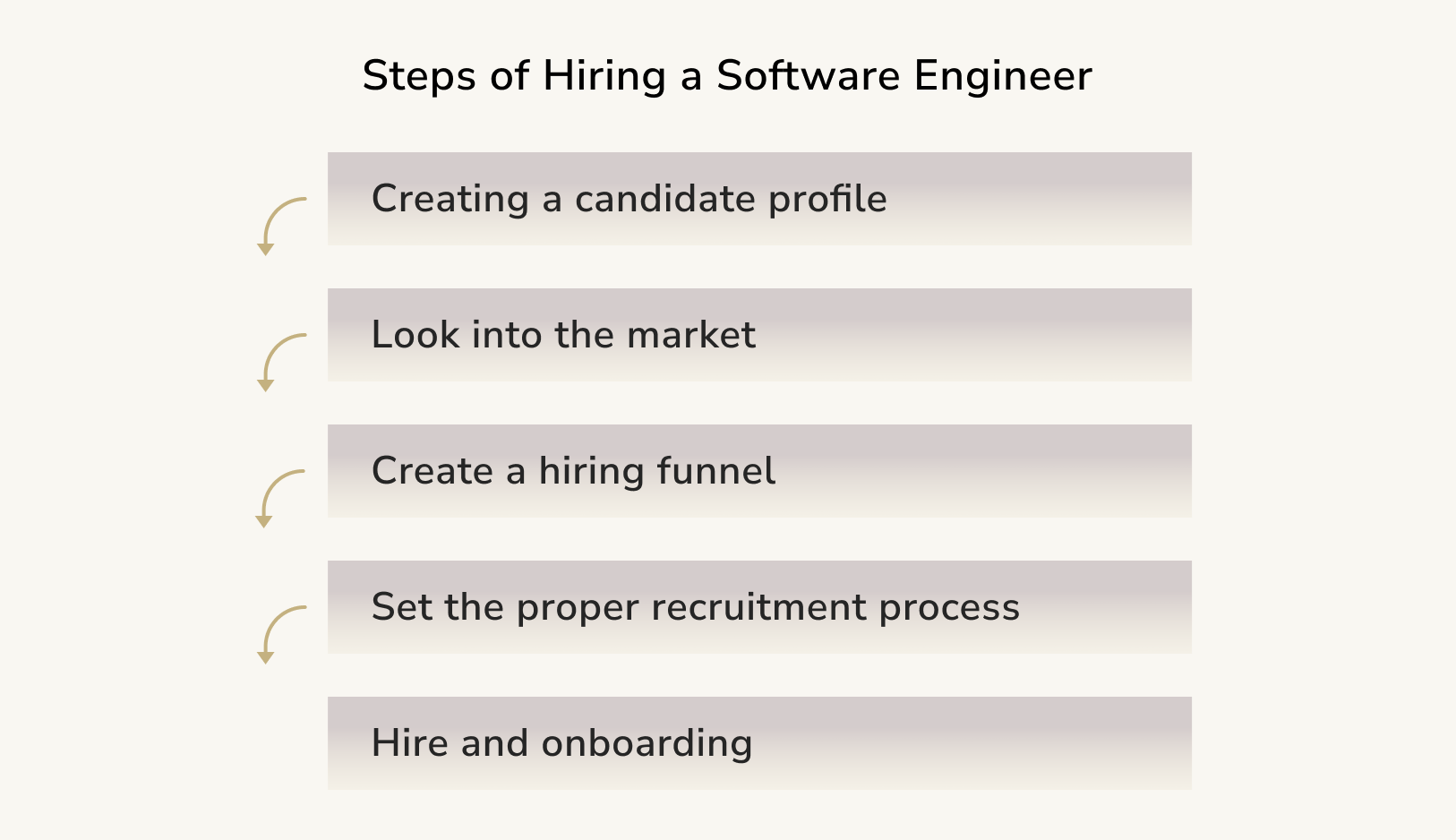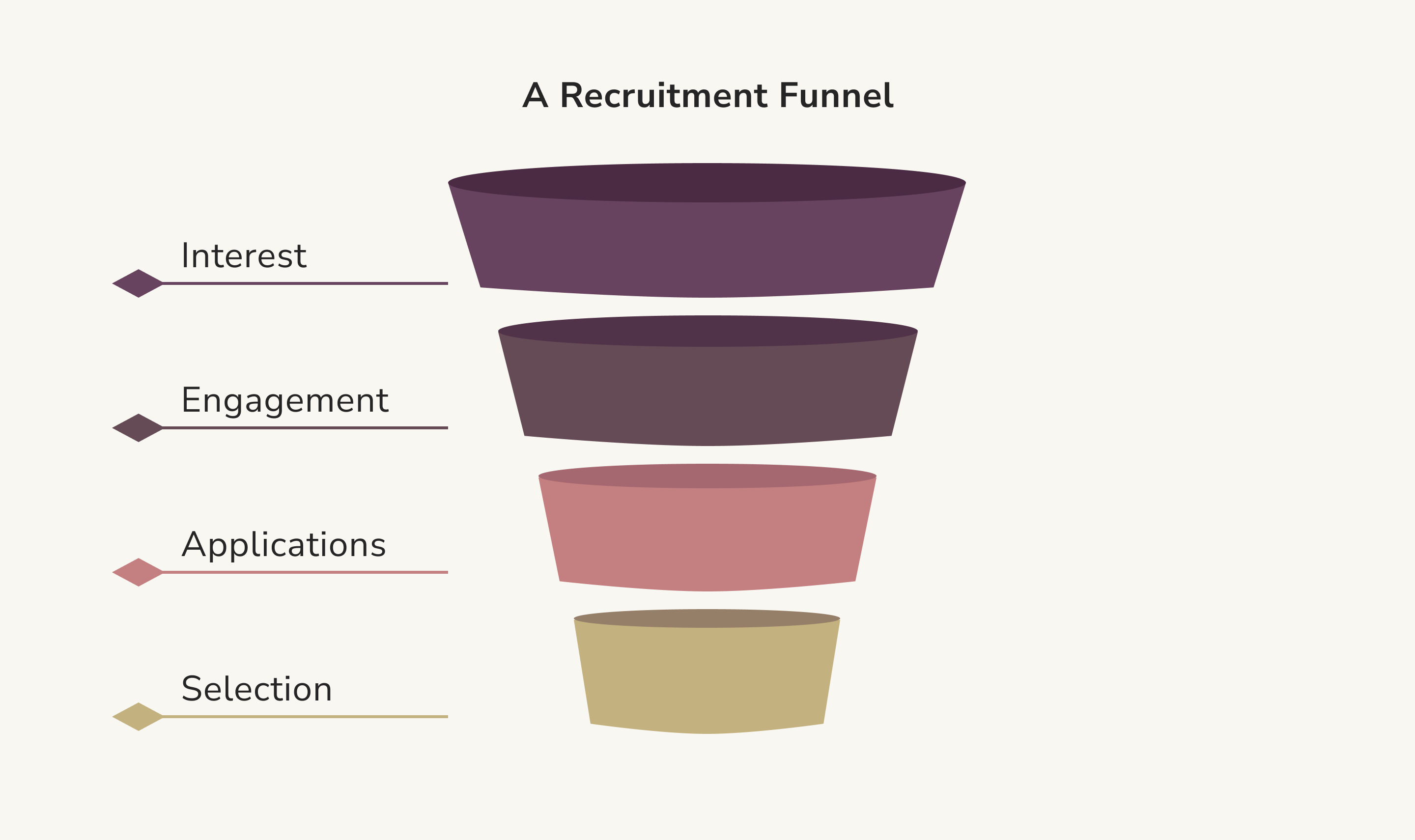A Startup Founders’ Guide to Hiring a Software Engineer

Recruiting software developers in 2025 has shifted focus from compensation towards prioritizing remote work, skills-based hiring, and effective headhunting strategies. Interestingly, 81% of employed developers are not actively seeking new roles (Stack Overflow 2023).
Data highlights a clear trend among developers, with 65% favoring opportunities for professional growth and learning over working for well-known brands, while 58% place greater importance on flexibility than on compensation.
Given the demand, the most skilled developers aren't browsing job boards. They're fully engaged with their current roles, building innovative products. The key to effective hiring lies in understanding how to locate and attract these passive yet highly talented individuals.
Signs You Need to Hire a Software Engineer
There's no doubt that software engineers bring immense value to organizations. However, how can you determine if their specialized skills are necessary to meet your project requirements and overcome current challenges? Identifying the right moment to onboard a new expert is essential for addressing bottlenecks and enhancing operational efficiency.
Below are key indicators that suggest it might be time to bring a software engineer onto your team:
- Your current team is consistently overburdened with tasks, leading to stress and burnout.
- Deadlines are frequently missed due to limited resources or operational constraints, slowing down progress.
- There's a noticeable skills gap causing frequent software errors, bugs, or issues, resulting in poor system performance.
- Existing software systems cannot adapt or scale in line with business growth or evolving demands.
- Continued reliance on legacy systems or outdated platforms is compromising performance, security, and competitiveness.
- Non-technical departments are frequently burdened with resolving technology-related issues, which detracts from their core responsibilities.
- A pattern of high turnover rates among developers paired with long and inefficient recruitment processes impacts momentum.
- The absence of fresh ideas in product development, features, or system enhancements is threatening the organization's ability to stay competitive.
These warning signals highlight the need to address gaps with skilled software development talent. In case you need to assemble a team of devs, it is best to opt for a software development partner who can ensure your access to top talent.
Common Skills and Qualifications to Consider When Hiring a Software Engineer
Identifying the need to bring software engineers on board is only the first step. To ensure you hire the right talent, it's crucial to pinpoint the specific skill gaps in your team or project needs. This evaluation helps you define clear job requirements and include a tailored list of necessary skills in the job description during the hiring process.
So, let's start with the technical background. The technical competencies required may vary based on the development environment and project at hand.
- Programming Languages. Proficiency in one or more programming languages such as Java, JavaScript, C++, Python, or Scala is essential. The selection should align with your tech stack and project needs.
- Object-Oriented Design (OOD). A deep understanding of concepts like encapsulation, inheritance, abstraction, generalization, and decomposition is critical for building scalable and maintainable software.
- Web Development. Knowledge of technologies and frameworks for front-end, back-end, or full-stack development is highly valuable.
- Database Management. Familiarity with database management systems like MongoDB, PostgreSQL, or MySQL is often a core requirement.
- Version Control. Experience with version control tools like Git is vital for collaborative development and codebase management.
- Development Methodologies. Understanding Agile, Scrum, or DevOps methodologies ensures effective teamwork and project management.
- Testing and Debugging. Strong ability to write and implement unit tests, conduct thorough code reviews, and perform debugging tasks to deliver error-free software.
- Cloud Computing. Practical expertise in using cloud platforms such as Google Cloud, AWS, or Azure can be a significant advantage.
- Mobile Development. Skills in creating mobile apps for iOS and Android platforms using technologies like Swift, Kotlin, or Java are valuable for mobile-first projects.
Note: When crafting your job requirements, focus on the technical skills that are essential for the specific role or project. For example, app development for mobile devices would require expertise in Swift or Kotlin and familiarity with frameworks such as React Native or Flutter. On the other hand, customizing a cloud-based CRM platform may necessitate proficiency in API integration, cloud architecture, and scripting.
Software engineers rarely work in isolation. Their roles typically involve collaboration with teams and interaction with internal or external stakeholders, project managers, and other team members. So, they need to develop and exhibit a range of critical soft and interpersonal skills. These include:
- Problem-Solving Skills. An ability to apply both analytical reasoning and creative thinking to address complex challenges and devise effective solutions.
- Attention to Detail. Precision and thoroughness in activities like documentation, coding, and testing to maintain high standards of product quality.
- Effective Communication. Strong communication and collaboration abilities to accurately interpret and share software project requirements, coordinate with team members, and engage effectively with stakeholders.
- Team Collaboration. A collaborative mindset and the capability to work harmoniously within a team, contributing toward shared objectives and fostering a supportive team environment.
- Time Management. Proficiency in organizing and prioritizing tasks to meet deadlines and achieve project milestones efficiently within a set timeline.
- Adaptability and Continuous Learning. Demonstrating a willingness to embrace new technologies and pivot strategies as necessary, such as incorporating advancements like AI development tools to enhance software quality and maintain a competitive edge.
Steps of Hiring a Software Engineer
With the preliminary steps for hiring software engineers complete, it's now time to explore the process in greater detail. Here's a comprehensive, step-by-step guide on how to effectively recruit software engineers.

Creating a candidate profile and identifying the requirements
Are you looking for a front-end developer, a back-end developer, or a full-stack developer? Are you planning a web SaaS solution or mobile app development? The first crucial step in hiring a software engineer is to create a detailed candidate profile that encompasses the specific skills, experiences, and attributes necessary for the role. This process begins with a thorough understanding of the project's requirements and the technology stack in use.
- Define Technical Skill Sets: Identify the key programming languages, frameworks, and tools necessary for the position. For example, if you're seeking a front-end developer, expertise in JavaScript frameworks such as React Native or Angular, and a strong grasp of HTML/CSS may be essential. Additionally, familiarity with version control systems like Git can be beneficial.
- Specify Soft Skills: Beyond technical knowledge, soft skills such as communication, teamwork, and problem-solving abilities play a significant role in a software engineer's success. It's especially imperative if you plan to build and structure a product team.
- Experience Level: Determine the level of experience necessary for the role. Will you require a junior developer with a couple of years of experience, or are you in need of a senior engineer with extensive project management experience? Consider factors like previous work in similar industries, contributions to open-source projects, or participation in hackathons.
- Educational Background: While not always necessary, a relevant degree in computer science or a related field can be a significant advantage. However, given the evolving landscape of software engineering, practical experience or certifications from reputable bootcamps or online courses may also be considered.
- Create a Job Description: With all this information gathered, craft a compelling job description that not only lists the requirements but also highlights the unique aspects of your company, the team culture, and the career growth opportunities available.
Look into the market
When you decided to turn your business idea into a real product, you undoubtedly did market research. A similar procedure will not be superfluous here. However, instead of researching your competitors, you'll need to delve deeper into the world of supply and demand in the IT job market.
Popular programming languages
During the previous step, you have already decided which specialists in which programming language you will be looking for. So now is the time to see how many engineers who use this language are on the market and how many competitive vacancies there are as well.
According to market research, the most popular development languages in 2025 are:
- Python
- Java
- JavaScript
- C#
- C++
This will mean that more and more engineers will learn these languages, but also that there will be more and more projects written in these languages.
Another detail you could take into account is the level of technology adoption. This can be done by checking Stack Overflow surveys that would demonstrate the popularity of various frameworks, for instance.
In general, it is better to rely on technologies that have already been on the market for some time as opposed to new ones. New technologies may be poorly tested and have no available libraries or services.
Note: As the growth of AI technology accelerates, businesses are eager to seize the opportunities it presents. A critical decision in this process is choosing between outsourcing AI development vs. relying on an in-house team. The challenge lies in the current shortage of skilled professionals, particularly Python developers, which makes sourcing the right talent increasingly difficult. On the other hand, training internal personnel demands significant time and financial resources. For many companies, outsourcing AI development emerges as the more cost-effective and efficient option.
Check popular IT destinations
Hopefully, it is already obvious to you, but let's repeat it again — it is not necessary to look for a development team only in your own country. The whole world of software development teams is available to you, and this only plays to your advantage (especially if you are looking for engineers who operate some not-too-popular programming languages).
Therefore, you have three options:
- Onshoring to different cities in your country;
- Nearshoring software development to neighboring countries or to the country in the same part of the world;
- Offshoring to distant countries.
Although it seems that the difference between these options is only the number of kilometers that separate you and your employee, if you dig deeper, the situation turns out to be more complicated. Take into account, for example, the time difference (and therefore, different working hours), the language barrier (yes, English is the global business language, but the level of language proficiency also varies), and differences in culture and mentality (which can be reflected at work as well).
Each of the aforementioned options has its pros and cons, which should be taken into account in the selection process. In addition, you should also learn more about the most popular IT outsourcing destinations in Eastern Europe.
What is the median salary?
While researching the market, of course, one should not forget about the salaries of developers. Especially when you are launching a startup and the issue of budget and expenses is especially important and relevant for you.
So let's take a look at the average salaries of software engineers in different countries:
- According to Indeed, the average base salary in the United States for a software engineer per year is around $125,000. But it can go as high as $197,000;
- In Brazil, for instance, the average base salary for a software engineer is $99,765 per year according to Payscale statistics;
- Speaking of Ukrainian specialists, Djinni website analytics shows that the medians of the lowest and highest salary ranges are from $24,000 to $48,000 per year.
As you can see, outsourcing to Eastern Europe is quite profitable from a financial point of view. It is not surprising that Ukraine has become one of the most powerful IT hubs in Europe over the last decade, taking into account the superb quality of high-quality software Ukrainian IT businesses bring to the table.
Create a hiring funnel and set the proper recruitment process
Once the candidate profile is established, the next step is to create a structured hiring funnel that encompasses the various stages of the recruitment process, ensuring a systematic approach to evaluating and selecting candidates.
- Sourcing Candidates: Utilize various platforms to reach potential candidates. This can include job boards like LinkedIn, Glassdoor, or industry-specific sites like Stack Overflow. Additionally, leverage networking events, tech meetups, and social media channels to attract passive candidates who may not be actively seeking new positions.
- Screening Resumes: Implement a systematic process for evaluating resumes based on the predetermined criteria from the candidate profile. This might involve using Applicant Tracking Systems (ATS) to filter out unqualified candidates efficiently.
- Initial Interview: Conduct phone or video interviews to assess candidates' technical knowledge and soft skills. Prepare a set of standardized questions to ensure consistency. This stage often includes preliminary coding assessments or technical challenges to gauge problem-solving abilities.
- Technical Assessment: Shortlist candidates from the initial screening for a more in-depth technical evaluation. This may involve coding tests, live coding interviews, or take-home assignments tailored to the specific skills required for the role. This step allows software developers to demonstrate their proficiency in a practical setting.
- Behavioral Interview: Following technical assessments, invite candidates for behavioral interviews. This is an opportunity to explore their experiences, work ethic, and cultural fit within the organization. Utilize the STAR method (Situation, Task, Action, Result) to structure questions effectively.
- Final Interview and Offer: The final step involves interviews with key stakeholders, such as potential team members or department heads. This discussion should focus on alignment with company values and long-term vision. Once a candidate is selected, prepare a competitive offer that includes salary, benefits, and opportunities for professional development.

Remember that with experience, you will only improve the funnel by adding new intermediate stages, and over time, this tool will become an integral part of the hiring process that will significantly simplify the process.
Hire and Onboard
Once a candidate accepts the offer, it's imperative to have a comprehensive onboarding process that integrates them smoothly into the organization.
- Pre-Onboarding Preparation: Before the start date, ensure that all necessary equipment (laptop, software licenses) and resources (documentation, access to repositories) are prepared. This proactive approach helps new hires feel welcomed and ready to contribute from day one.
- Orientation Program: Conduct an orientation session to introduce new software developers to the company culture, mission, values, and organizational structure. This may include presentations by different teams, a walkthrough of company policies, and an introduction to key personnel.
- Mentorship and Support: Assign a mentor or buddy to the new hire who can guide them through their first few weeks. This support system helps build relationships and provides a resource for any questions or concerns they might have.
- Training and Development: Provide access to training resources tailored to their role. This could include onboarding sessions on internal tools, coding standards, or project management methodologies. Encourage participation in continuous learning opportunities to foster professional growth.
- Feedback Mechanisms: Establish regular check-ins during the first few months to assess the new hire's integration and satisfaction levels.
Common Mistakes
When hiring a software engineer, there are several common mistakes that can impede your project's progress. Below are the key pitfalls to watch out for and how to avoid them:
Hiring the Wrong Developer for the Role
Selecting a software engineer whose skills do not align with your project's requirements can disrupt the entire development process. For instance, if your project involves front-end development, hiring a front-end developer or a full-stack programmer is essential. Similarly, mobile software solutions require the specific expertise of either iOS or Android developers. Hiring an iOS developer for an Android project, for example, results in wasted time and resources.
To avoid this misstep, thoroughly assess your business and project needs first. Clearly define the development skills necessary and ensure the candidate's expertise matches your specific requirements.
Failing to Prioritize Experience
Experience plays a critical role in hiring the right software engineer. The complexity of your project typically dictates the level of expertise required. While hiring a junior developer may seem cost-effective initially, it often leads to limitations in handling complex tasks effectively.
For more intricate projects, hiring senior developers with significant experience is crucial. However, for simpler projects, mid-level or junior programmers can suffice, provided a senior developer oversees their work to maintain quality and direction. Align the candidate's experience level with your project's technical demands to achieve optimal results.
Overlooking Cultural Fit
Cultural fit is a vital yet sometimes overlooked aspect of hiring dedicated software developers. Cultural fit determines how well a developer aligns with your organization's core values, work culture, and collective behaviors. Hiring an engineer whose ideals and priorities clash with those of your team can result in workplace tensions and inefficiencies.
When scouting for candidates, remember that you're not simply hiring someone to write code but a team member who must integrate seamlessly with others. Start by identifying your company's core values and use them as a basis for assessing candidates. This proactive approach will help you establish a collaborative and productive work environment.
Conclusion
Hiring a software engineer demands careful preparation and thorough understanding. Begin by identifying your project's specific requirements and creating a comprehensive list of the technical skills necessary to achieve your goals. Evaluate hiring methods that align with your needs, and don't overlook the importance of assessing soft skills, as they are crucial for team collaboration and productivity. While the process may seem challenging initially, the more effort you put into preparation, the higher your chances of finding the ideal candidate.
At Impressit, we strive to empower our clients by transforming their ideas into actionable solutions, ensuring they achieve market success. Our mission is to collaborate with global brands that are committed to shaping the future through the use of innovative and cutting-edge technology.

Roman Zomko
Other articles